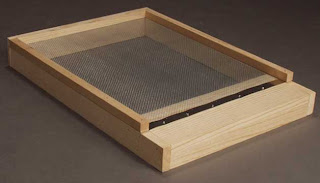| Solid Bottom Board with entrance reducer - as it's name implies, the bottom boards are the base for the rest of the hive |
With the first inspection of the season, we found that the underside of the cover of the Sicilian Beehive was damp and peeling. We assume that this was caused by a build up of excessive condensation during the winter. However, the lid of the Italian hive showed no such damage. We have come to the conclusion that this is in all likelihood due to the fact that the Italian hive has a screened bottom board which helped in some way to reduce the condensation, whereas the Sicilian hive has a solid bottom board. Were the beehives to spend a second winter at the side of my house I think we would have dispensed with the solid bottom boards altogether and would have switched to screen bottoms only. However the bees have been moved to a friend's farm, and the beehives are exposed to more sun and wind now. Perhaps with the change in their environment the bottom board may now be an asset, though we won’t know for sure until they have overwintered for a second season.
 |
| Screened Bottom Board - hardware screen allows for easy ventilation |
I begin to suspect that a good beekeeper is one that pays attention to the condition of the beehive in respect to the environment it is located in, and that just like bees, hive design needs to adapt to local conditions, as what may work in Florida may not work so well in Maine.
It will be interesting to see what the lids will look like next spring.
Posted by John Rodgers
The Sicilians would have gotten a screened bottom board as well, but when I went to the parts to make the hive the supplier was fresh out of them. (see: http://naturalbeekeepingblog.blogspot.com/2010/05/third-hive.html for the full story)
ReplyDeleteLast night I realized we could rectify the "damp" problem by replacing the current bottom board with the one from the empty hive and then revamp the solid bottom board by cuttin out a large portion of the board, leaving a frame, and then adding screen to ventilate it. In reading Conrad's Natural Beekeeping, he strongly recommends screened boards as a physical control for varroa mites. Mites occasionally lose grip and fall off bees (assuming an infestation of them of any size). With a solid board, they can climb right back up into the hive and continue their destructive habits. But if they fall through a screened board, they are lost forever. And that's a good thing!
I'm currently working out in my head how to make the top bar hives screened as well for the same reason. However, I need to figure out how to put a solid bottom in for the wintertime to help insulate the bees. Hmmm...even as I write, ideas are springing from my head!
putting a solid bottom in is easy. Buy a router like 50 bucks and cut a groove in each side of the interior bottom board supports or get you some 2X4s or whatever thickness and do this and just screw it to the current bottom board. In the winter you can slide in a thin piece of wood some sticky plastic whatever you need.
ReplyDelete